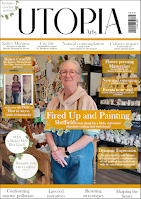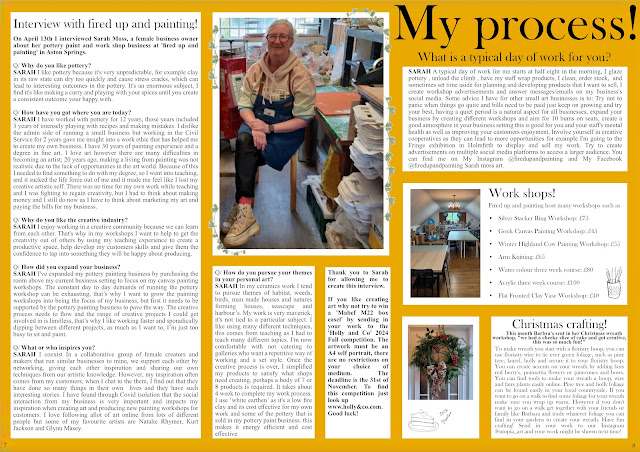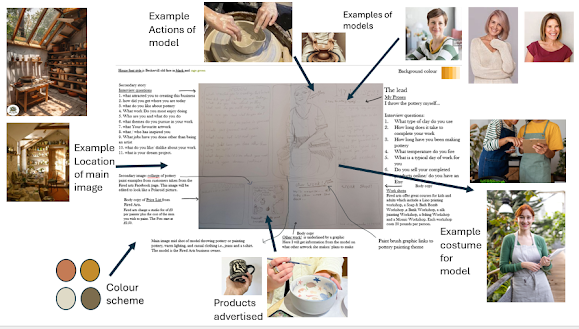Front cover
I have met the brief by creating the front cover of a new magazine aimed at a Sheffield audience that has all been originally produced by myself created on desktop publishing software. I have been able to produce a proposal with sample materials for an original media product to a client brief, plan and develop pre-production materials for an original media product to a client brief, create production materials for an original media product to a client brief and carry out post-production techniques and processes for an original media product to a client brief.
I met my proposal ideas by creating an aesthetically cozy magazine that will entertain the viewers in their free time and provide information and promote and advertise different local artistry business and events in Sheffield for the reader to enjoy, advertise their product and business in and learn from as a relaxing activity.
I appealed to my audience of ABC1 women aged 35-50 by featuring middle aged women on my front cover so that the reader can relate to the model and are encouraged to view them as an ideal self, to do this I have taken Laura Mulvey's male gaze theory into consideration and subverted the male gaze by dressing my model appropriately in mainstream clothing item so that it is relatable to the target audience. Stereotypically an ABC1 audience is more intellectual meaning they will want to read a magazine that has allot of text and more dense wording. Because of this I included many cover lines and richer more complex wording. The artwork I chose in the secondary image of my front cover is a stereotypically femenin butterfly displayed to stereotypically target my female readers.
I met my proposal ideas and appealed to my genre of 'small local arts business' by following codes and conventions of the genre such as presenting artwork on my front cover, advertised local 'events' in Sheffield, selecting topics of interest to business owners and artists on the cover lines, choosing a small art business for my main cover story and having a minimalist aesthetic.
DPS
I think I have met the brief for creating a local art and business magazine that targets middle aged women. This is because I have followed magazine conventions by advertising my DPS main article and competition advertisement on my front cover creating synergy with my front cover, this cohesiveness strengthens 'Utopia arts' brand identity.
In my double page spread I have Interviewed a business local to Sheffield and used them as my articles main subject matter, this helps me focus on my target audience of people that live and or work in Sheffield because local art businesses will be something they are interested in. My article follows magazine conventions as its laid out in columns.
My text follows magazine conventions for clear and easy reading because all text except the headline has a white background, its main body size is 12 and all of the text is black. This is important as my audience enjoys having allot of reading material.
I have met my brief by using a specific house style in my DPS. This is shown through my use of select colours; yellow, black, white and green, I have consistently used serif fonts only and I have kept my text sizing consistent.
All of my images connote my art theme due to my chosen setting and subject matter. Most of my readers can easily see my models as ideal selves because they are middle aged women like my target audience. All of the costume's in my magazine are relaxed and mostly business appropriate this helps my target audience of women in the art business relate to my models. However I think if I was able to oversee what my models were wearing I would change their costumes and dress them in a more business appropriate style. The warm lighting in my images connote comfort and denote natural lighting. I have included art setting's such as the 'Fired up and painting' workshop to inspire my readers that want or have an art business themselves.
My DPS layout follows magazine conventions because I have sectioned out my pages based on the story I am concentrating the writing on and added images to make the page more visually appealing. Unlike my front cover my DPS pages are not overly busy and loud as I want the reader to relax and easily focus on different sections of the DPS. The graphics in my DPS connote my art theme and connote a friendly and happy mood to my readers.
Contents page
I have met the brief with my contents page as I have targeted a local audience by featuring a museum that is local to Sheffield in one off my images. I have targeted artists and people interested in art as I have displayed images of art instillations around Sheffield city center, this may encourage locals living in Sheffield to go out and look at street art with their friend and family, by making my content interactive I have engaged my readers. because of featuring stereotypically femenin subjects my images of flowers and home decoration target my target audience successfully. I have used daylight as my lighting source for all my images this connotes energy and warmth this causes my images to connect with my content pages light and calm mood.
I have appealed to my target audience of middle aged ABC1 women because I have used stereotypically femenin subjects in my photography and text such as plants, decoration, art, galleries, bright colour and places to go out with friends and family. The models from my front cover main image will help my viewers to relate to my magazine as they can see their image and personal image as well as their interests being represented. I have also appealed to my secondary audience of young adult women as I have featured colours and decretive styles that are in relevant and fashionable. Because of this I think I met the brief of targeting a specific audience.
I have used conventions of the art genre with good quality images of art and a variety of themes in my subject matter. I have followed conventions with my small business genre as I have target my readers with a formal mode of address and advertised local businesses.
My layout follows conventions by highlighting the prominent stories in my magazine. I have chosen themes for my listed stories that relate to art and business.
I have consistently followed my house style as I have used the serif font Baskerville old face, this makes my text appear professional and minimalist. I have also repeatedly used vine graphics that have been created in my house style sage green shade, these graphics create synergy and brand recognition due to there uniqueness, as conventual magazine graphics consist of patterns and speech bubbles/highlights.
To meet my brief more I think I could have researched more small art businesses in Sheffield and used them as my stories on my contents page.
I have used the text tool to create my masthead and body text to connote professionalism this has allowed me to target my main target audience of 89% women aged 35-50, as they are employed or have their own business and regularly use professionalism in their day to day
I have aimed my magazine at a local audience as I have featured a business based in Sheffield with my main image and I have targeted my audience of middle aged women by featuring a middle aged model. 11% male and 89% female, ABC1 80%.
I used the colour pick tool and box tool to create yellow boxes to highlight my text. I chose a colour scheme that wasn't stereotypically hyper femenin so that it feels more accessible to my secondary target audience of my 11% middle aged male readers in the ABC1 category.
I've added in graphics and resized them using the hover tool to draw attention and emphasize my nature theme by depicting vines to use as borders. This engages my main target audience of middle aged women as they are stereotypically interested in plats and gardening. I also added another white graphics in the bottom left corner to fill up unused space.
I re-used my asset graphic from the top left of the magazine to draw interest to the main cover storyline. I also changed the opacity of the yellow box highlighting my main cover line using the opacity toggle so that it stands out in comparison to my other stories.
I made a page sized width 42 cm to length 29 cm. I first added a grid to my page using the view tab so that my pages would be even. I then added a line to the middle of my page so I could see where the crease would be. I made the page mustard yellow using the squire and colour selection tool. I made white boxes using the squire and colour selection tool to map up my text and images following my mock up layout. I used my house style typography Baskerville old face: body text size 12, masthead sized 96, tagline sized 24.
I mapped out my other images using the squire and colour selection tool.
I used the mustard yellow colour and placed it with the bucket fill tool to connote happiness and importance.
I added in my updated interview body and sub-heading text. I changed the font to Times new roman. I changed the layout to fit all my text on the double page spread and I added in a editors note and competition advertisement. As my DPS is mainly text about a local business I have targeted a local
Sheffield audience and my main target audience of women age 35-50 as stereotypically they are interested in media with allot of reading material. As the themes of my DPS is not stereotypically hyper femenin I have also targeted my secondary audience of middle aged men.
I added in my headings using the text tool and altered the size and font, I added descriptions and page numbers. I added in boxes to plan out my layout.I added in my assets and changed my text graphic to be the same shade of green using the dropper tool.
In my first version I loosely laid out where I wanted my images to go basing it off of my visualization diagram. I surrounded my contents page text with images that relate to the story's advertised in the text, so that my contents page could be more visually interesting and so that the reader can quickly see what is included in the magazine.
I added in a purple box as it contrasted with the green box and made it stand out, I did this as the story it links to is about colour.
I added in a graphics to my background and foreground to connote movement.
I added in my text based on my visualization diagram, however I did alter some of the headings numbers and descriptions.
Due to my feedback I found the grid I added in made it hard for the viewer to read the text so I enlarged it so that it interacted less with my text making it easier to read.
In reply to one of the comments I resaved I moved my image of the site gallery behind my graphic to create more depth and draw attention to my graphics so that they didn't blend into the background.
I have aimed my magazine at people local to Sheffield as i have featured street are in Sheffield city center in my images. I have target my audience aged 35-50, 11% male and 89% female, by using bright colorful art that engages my viewer with content they are interested in. My ABC1 audience has been targeted as I have featured art and home décor that only people with a disposable income are likely to purchase.









hh.PNG)
.PNG)
.PNG)
.PNG)
.PNG)





























